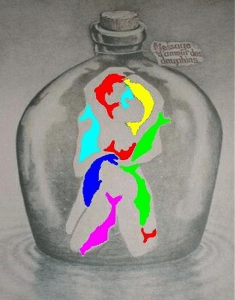We are habitual people. If we want different results, we need to start doing things differently. In this series I’ll share tips that you can apply to your own life and start changing from within.
The map is not the area.
Tip 2: Change your map
This means everyone has their own version of the same reality, or their own map of the same area. All information you’re receiving every second gets filtered, tested against your own values, beliefs, experiences and eventually a small part of that input gets through to your consciousness. Each second, we’re receiving at least 11 million stimuli that our subconscious processes. On average, only 60 stimuli get through to our conscious, and those 60 we use to build our reality. So, what you see is not the real; it’s your interpretation of the real.
Think about a car accident: five witnesses, five different stories, while all have seen the same misfortune. A young man might find it a waste of that expensive car, while a mother only hopes the child inside the car is okay.
Or how about a movie you’ve seen several times. Can you relate to the fact that when you see the movie another time, something new catches your attention that you didn’t see before? It’s still the same movie!
Let me give you another example: Imagine you bought a new car. You feel like a king driving it, and suddenly you see the same model everywhere. You might even think, “Great, now that I have a new car, everyone is suddenly driving it!” Surprise, the car has been on the market for two years already. Your next door neighbor has been driving the same car for half a year and you never noticed it consciously. Maybe even the fact that you passed his car on a daily basis was the very reason you started liking it. Only back then it didn’t have your focus yet and that information was filtered out.
What’s your frame of reference?
Your own frame of reference determines where your focus lies. The following picture is well known:

PICTURE #1
One sees the young woman first; the other sees the old woman first. And once you see one of the two, it takes a lot of effort to see the other person.
Look at the next illustration, which is perhaps less well known, and in my opinion even more appealing how life experience determines your frame of reference. What do you think a toddler sees in this picture?

PICTURE #2
Indeed, a lot of dolphins! The label on the jar already hints to it. If you still don’t see it, check the end of this article.
The examples above show how your inner thoughts are adjusted as we grow up and how you unconsciously limit your own thoughts. So, remember to be aware of your frame of reference and realize that others can have a different frame of reference.
Discover their frame of reference
When you know other people’s frame of reference, your message will be received and understood way better. Let me give you an example:
You’re walking down the street and a car stops next to you. The driver is lost and asks your help. Let me give you two ways to respond:
- You immediately tell the man the way. “Yes, I know that. Just at the end of the street, turn left, take the second right, roundabout straight, then the third left, second right, and immediately the first left, and you’ve reached your destination.”
That may sound very logical to you, but the poor man might think after the second right, “What was the route again?”
- You first ask a question. “Yes, I know. May I first ask how you got here?”
“Well, I went down the highway, past the petrol station, took a left at the supermarket. At the mill, I turned right and here I am.”
Now you know his frame of reference: he’s using visual landmarks.
“Okay, if you turn here, turn right at the mill. Drive up to the farm with a thatched roof. Turn left there, and then at the riding school on the right, and then turn left around the riding school and then you are there.”
In the first answer, you use your own frame of reference to tell the route, because that comes naturally to you. In the second answer, you learn the frame of reference of the driver so that you can explain the route in the same language.
Now think back to some conversations where your message didn’t stick. What was your frame of reference? Did you use jargon that seemed normal to you and your colleagues? Did you really tune into their favourite radio station WIIFM?
“Client’s favourite radio station WIIFM –
What’s In It For Me”
It is important to tune into their radio station, so your focus should always be what’s in it for them. When you’re an expert in your field, you tend to use jargon, because it comes so naturally. However, most of your clients aren’t used to that jargon and don’t have a clue what you’re talking about. I am still guilty of it, even though I am aware. The challenge is to use their language, or like one of my coaches said, “Speak like you’re talking to a 3-year-old.” If a toddler could understand what you’re saying, your message is clear.
When you’re talking to prospects, understand what they are looking for. They want to know the results you can deliver, what they will get out of it if they choose to work with you. They aren’t interested (at first) about the process or the features. They just want to know what’s in it for them, what they get out of this deal. You might know what they need, but 9 out of 10 times, that’s not what they want (to hear).
Move into their world
If you find it difficult to tune into your client’s point of view, I have a fun exercise that you can play with your friends. It is called the “Yes, let’s” game. Let me explain how it works:
- You need at least two persons present to participate.
- Person A sets a scene. He/she describes the scenery and makes an offer to go somewhere or do something. (“Let’s…”)
- The other person has to fully accept that offer (the “Yes” part) and build the next scene. Then that person makes an offer to the first person (or the next in case of more participants).
- The first (or next) person has to fully accept that offer and take it from there.
- Repeat until you’ve had enough.
- In case you feel that your offer hasn’t been fully accepted, you stop the game and explain why you didn’t feel your offer was fully accepted. This is a learning moment for all participants.
Let me give you two examples, played by two persons A and B:
Example 1:
- A: “Okay, so we’re in a theme park. It’s a wonderful day, 77° Fahrenheit (25° Celsius), and it’s still early in the morning. We just entered the park and wonder what to do first. Let’s go to that great rollercoaster over there!” (first offer)
- B: “Yes, let’s do that. Oh boy, there is a whole queue waiting for the rollercoaster. The sign says there’s an hour wait from this point. Oh look, there’s a coffee shop. Let’s go get a cup of coffee!”
- => STOP! The offer of A wasn’t fully accepted. Actually, it seems B wasn’t interested in going into the rollercoaster and rejected the offer. If B had fully accepted the offer, A and B would have been sitting in the rollercoaster. Step 2 would have looked like, “Yes, and there we are. We just entered the rollercoaster, and the moment the lock closes, we ask ourselves why we chose this one to be the first attraction of the day.” And so on. B is still hesitant (maybe B doesn’t like rollercoasters in general), but at least the offer was fully accepted.
Example 2:
- A: “Okay, so we’re in the zoo. It’s a wonderful day, 77° Fahrenheit (25° Celsius), and it’s still early in the morning. Let’s visit the elephants!”
- B: “Oh yes, look at these magnificent creatures. So big, yet so elegant using their trunks. And look at that little one, how playful it is running after the birds. What do I hear? Oh, it’s the monkeys. Let’s go look at them!” (A might have heard lions, but now he has to adjust his mental image to monkeys.)
- A: “Oh yeah, look at those gorillas.” (B might have thought of orangutans, so he has to adjust his image instantly.) “What a power animal! Especially that big one with the white lining on his back. That must be the leader. Funny to see how they actually eat a banana. According to the schedule, it is almost feeding time for the tigers. Let’s visit them!”
- And so on…
It is a fun game to play, but there’s also an important lesson to be learned and trained. Let me give you a real live example in which I applied the “Yes, let’s” game:
A long time ago, I was approached by a friend who manages a FB group for people with depression and other mental issues. One of the members was having a psychosis. The man felt he was in a war and had to go out and fight. He had to kill them first before they could get to him. No matter what suggestions people gave, he kept saying he had to fight for his life. My friend asked me if I had any suggestions how to deal with it, because she felt responsible (it was her group). I gave her the following advice that just popped into my head:
“Give him the following suggestions:
- I’m sorry to hear that you are in a war right now, but it seems that you have survived every battle till now. So apparently you have a little angel sitting on your shoulder, taking care of you. That must be a great feeling.
- And since you’re in a war, you’re not alone. Others are fighting the same war. So maybe it’s time for you to step back for now and let the others fight this battle for you.“
She gave him these exact suggestions and instantly the man calmed down, thanked her and everybody for sticking with him, and apologized.
This to me shows the power of this “simple” game. Accept the reality of the other person and start giving suggestions from that side to guide them to a better place.
The picture from a toddler’s point of view
As promised the point of view from a toddler. Now you know why it is called “Message dámour des dauphins”, the message of love from the dolphins.

PICTURE #3

